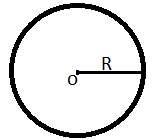Question
Question: A solid sphere of radius R has a charge Q distributed in its volume with a charge density \(\rho =k{...
A solid sphere of radius R has a charge Q distributed in its volume with a charge density ρ=kra, where ‘k’ and ‘a’ are constants and ‘r’ is the distance from its centre. If the electric field at r=2R is 81 times that at r = R, find the value of a is
Solution
We are given the radius and charge density of a solenoid. We need to find one of the constants given in the value of the charge density. Since we are given the relation between the electric fields in two different cases, we can find those electric fields and equate them. Thus we will get the solution.
Formula used:
E=4πε01r2q
q=0∫rρdv
Complete answer:
In the question we have a solid sphere with a radius R.
A charge ‘Q’ is distributed in the volume of the sphere and the charge density is given as, ρ=kra, where ‘k’ and ‘a’ are constants and ‘r’ is the distance from the spheres centre.
Consider the figure of the solid sphere given below.

First let us find the electric field on the surface of the sphere, i.e. when
r=R
We know that the equation for electric field is given by,
E=4πε01r2q, were ‘q’ is the charge and ‘r’ is distance.
Therefore the electric field on the surface of the given solid sphere will be,
E1=4πε01R2Q1
Here we need to find the charge on the conductor.
We know that total charge is given by the equation,
q=0∫rρdv
Therefore the charge on the surface of the conductor for the given solid sphere will be,
Q1=0∫Rρdv
We know that volume of a small area on a sphere ‘dv’ is,
dv=4πr2dr
And we also know the value of charge density ρ
By substituting these values we get,
⇒Q1=0∫Rkra(4πr2dr)
Now we can take the constants out of the integral. Thus,
⇒Q1=4πk0∫Rrar2dr
⇒Q1=4πk0∫Rra+2dr
Integrating this we will get,
⇒Q1=4πk×[a+2+1ra+2+1]0R
⇒Q1=4πk×[a+3ra+3]0R
⇒Q1=4πk×(a+3Ra+3)
Therefore we get the electric field on the surface of the given solid sphere as,
E1=4πε01(a+3)R24πk(Ra+3)
By simplifying the above equation we get
⇒E1=ε01(a+3)kRa+1
This is the electric field when r=R.
Now we can find the electric field at r=2R.
Similarly, we get
E2=4πε01(2R)2Q2
Now we need to find the total charge at r=2R.
Let Q2 be the total charge at r=2R, then
Q2=0∫R/2ρdv
We know dv=4πr2dr and ρ=kra. Therefore,
⇒Q2=0∫R/2kra4πr2dr
By solving this,
⇒Q2=4πk0∫R/2ra+2dr
⇒Q2=4πk[a+3ra+3]0R/2
By applying limits, we get
⇒Q2=4πka+3(2R)a+3
Therefore the electric field at r=2R will be,
E2=4πε01(a+3)(2R)24πk(2R)a+3
By simplifying this we get,
⇒E2=ε01(a+3)k(2R)a+3(2R)−2
⇒E2=ε01(a+3)(2)a+1k×Ra+1
This is the electric field when r=2R.
In the question it is said that the electric field when r=2R is 81 times the electric field when r=R, i.e.
E2=81E1
By substituting the values of E1 and E2, we get
⇒ε01(a+3)(2)a+1k×Ra+1=81ε01(a+3)kRa+1
⇒(2)a+11=81
⇒2a+1=8
We know that 8=23. Therefore,
⇒2a+1=23
From this we can see that,
⇒a+1=3
Therefore,
⇒a=3−1=2
Hence the value of ‘a’ is 2.
Note:
While finding the electric field when r=2R, we might eliminate the common terms at the beginning itself. i.e.
E2=4πε01(2R)2Q2
If we eliminate the common terms now itself, we will get
⇒E2=4πε01R24Q2
⇒E2=πε01R2Q2
This is a simple form of E2. But if we do so we might feel difficulty while equating this with E1. Hence try not to simplify E2 first itself.
